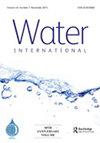走向价值和秩序的一致性:国际水利项目的合作战略
IF 1.5
4区 环境科学与生态学
Q3 ENGINEERING, CIVIL
引用次数: 1
摘要
摘要本文论述了世界银行、亚洲开发银行、非洲开发银行、欧盟、美国和日本等发展中国家水资源项目的政策原则和战略模式。为了解决冲突和风险,他们按照类似的逻辑调整了不同的框架。然后,结合一致性策略、方法论扩散策略、社区参与策略和资源激励策略,确定了一个双轨可持续模型——同构价值和共生秩序。本文章由计算机程序翻译,如有差异,请以英文原文为准。
Towards consistency of value and order: cooperation strategies of international water projects
ABSTRACT This article discusses the policy principles and strategy models for water resources projects around developing regions of the World Bank, the Asian Development Bank, African Development Bank, European Union, United States and Japan. To address conflicts and risks, they adapted different frameworks following a similar logic. A two-track sustainable model – value of isomorphism and order of symbiosis – is then identified, combining strategies of consistency, methodology diffusion, community participation and resource incentives.
求助全文
通过发布文献求助,成功后即可免费获取论文全文。
去求助
来源期刊

Water International
工程技术-工程:土木
CiteScore
4.40
自引率
7.70%
发文量
58
审稿时长
6-12 weeks
期刊介绍:
Water International is the official journal of the International Water Resources Association (IWRA), founded in 1972 to serve as an international gateway to the people, ideas and networks that are critical to the sustainable management of water resources around the world. Water International''s articles, state-of-the-art reviews, technical notes and other matter are policy-relevant and aimed at communicating in-depth knowledge to a multidisciplinary and international community. Water International publishes both individual contributions and thematic special issues and sections on cutting edge issues.
All individual manuscript submissions are subject to initial appraisal and peer review by the Deputy Editor in Chief and the Associate Editors, and, if found suitable for further consideration, to peer review by at least one independent, anonymous expert referee. All external peer review is double blind. Thematic issues and sections are handled under comparable procedures by guest editors under the oversight of the Editor in Chief.
 求助内容:
求助内容: 应助结果提醒方式:
应助结果提醒方式:


